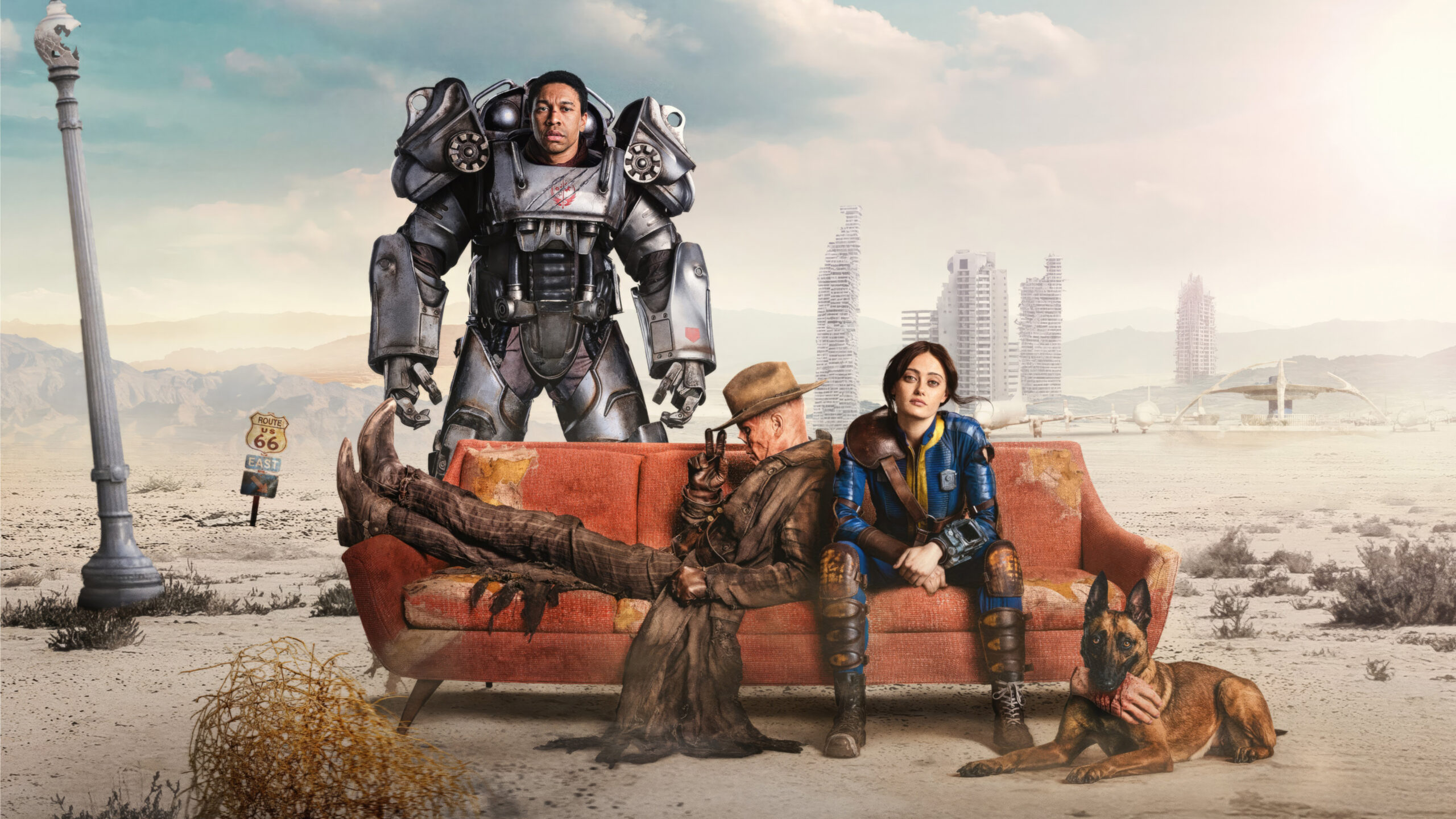Table of Contents Show
After a prolonged era of mediocre video game adaptations for television, fans of “Fallout” (1997-) were pleasantly surprised by the reception of Amazon Prime Video’s Fallout (2024). The show garnered acclaim from both fans and critics, with The Guardian describing it as ‘immaculately made,’1 Forbes calling it a ‘terrific’ and ‘faithful adaptation,’2 and Variety praising it as an ‘intensely fun’ exploration of humanity in the 23rd century3.
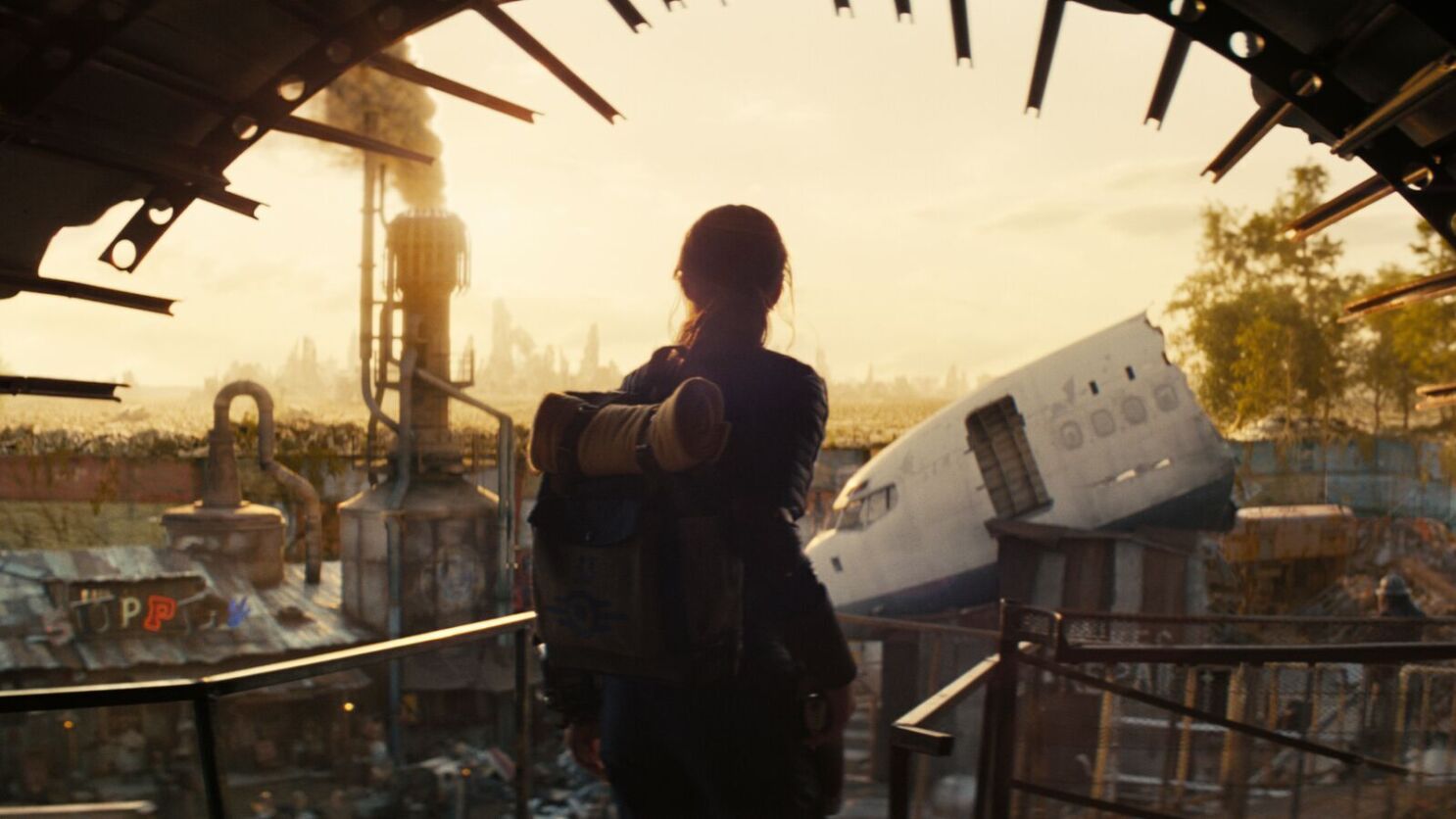
Fallout (2024) is far from the first dystopian drama adapted from a video game, but it distinguishes itself within the genre by offering a satirical twist on post-apocalyptic and Western narrative tropes. The implications of the series’ genre-bending efforts have been discussed at length; however, the significance of Fallout (2024) as a ‘post-western’ remains relatively unexplored.
To delve deeper into this topic, the following research question is posed: How does Fallout (2024) effectively cultivate a critical perspective on contemporary American sociopolitical attitudes? Through a textual analysis of the series and in the company of existing post-Western scholarship, it is evident that through strategic characterization and environmental storytelling, Fallout (2024) offers a substantial critique of American exceptionalism. This critique is most evident in the dystopian re-envisioning of postmodern America and in the deconstruction of dominant narratives surrounding the American West, including what Mateusz Bogdanowicz calls the ‘American myth’4.
“Fallout” — History & Summary
“Fallout” (1997-) is a series of role-playing video games set in post-apocalyptic America. Initially developed by game developers Tim Cain and Leonard Boyarsky at Interplay Entertainment, the first “Fallout” game debuted in October of 1997, marking the beginning of a franchise that has enjoyed sustained success and critical acclaim for nearly twenty-seven years.
The world of “Fallout” (1997-) presents a fictional depiction of the United States after the Second World War, characterized by the widespread adoption of futuristic technologies and rapid technological advancement that transformed the nation into a utopia previously only conceivable in science fiction. However, by 2052, global resources had significantly depleted, leading to a devastating global conflict known as ‘The Great War,’ which culminated in October of 2077 with a full-scale nuclear event that eroded the United States, resulting in the post-apocalyptic landscape depicted in the “Fallout” series.
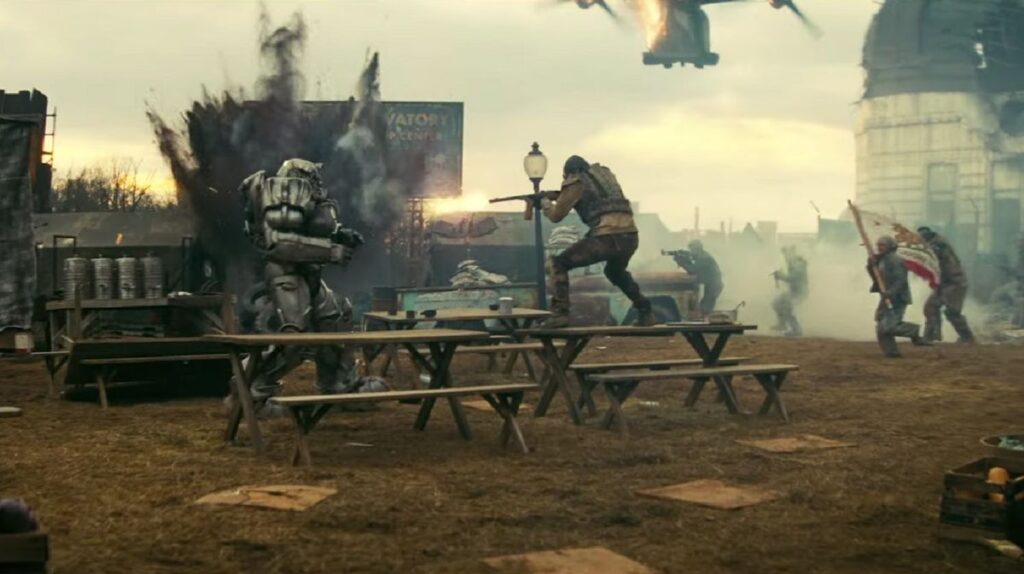
Each installment of “Fallout” (1997-) varies in context and locale, yet they all portray a world ravaged by similar calamities. Scarce resources, mutated wildlife, and societal collapse define the harsh realities of the nuclear wasteland. Players navigate these challenges while pursuing their objectives, whether that be finding their son (“Fallout 4″, 2015), seeking revenge (“Fallout New Vegas”, 2010), or, in the case of Lucy, the protagonist of Fallout (2024), rescuing her captive father. What remains consistent, however, is that those who confront the wasteland must exhibit adaptability, resilience, and everything that makes them ‘SPECIAL’.
The story of Fallout (2024) introduces a plotline that, although distinct from those found in the games, seamlessly integrates into the established canon. Set in Vault 33, an expansive and self-sufficient fallout shelter beneath Santa Monica, the series follows the aftermath of a violent invasion that results in the abduction of the vault overseer, Hank, who is also the father of the protagonist, Lucy. Determined to rescue her father, Lucy embarks on a journey through the wasteland. The series also features two significant subplots, one following a recently promoted Squire affiliated with The Brotherhood of Steel and another following an over 200-year-old actor who survived the fallout after radiation exposure extended his lifespan. The paths of these three characters intersect, as it is revealed that their goals all indirectly align.
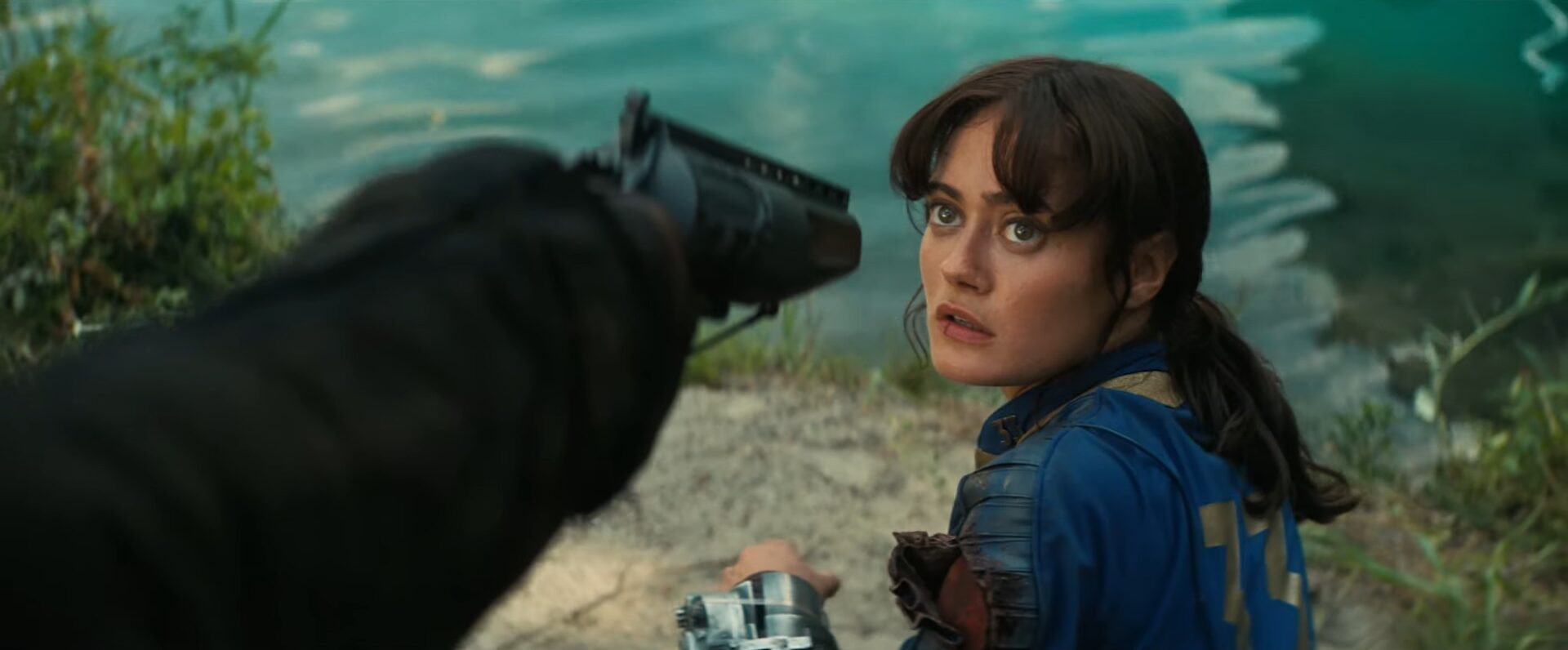
In the absence of a metropolitan Los Angeles, Fallout (2024) presents a return to the American Frontier, capturing the essence of the southwestern United States with the familiar signifiers of cowboys, outlaws, and vast expanses of desert. However, Fallout (2024) distinguishes itself from traditional Western narratives; in fact, some may hesitate to call it a Western at all.
Although the nuclear fallout has returned the Western setting into a pre-modern state reminiscent of the developing American Frontier, post-nuclear America is in strong opposition to the ideological implications of the region. Unlike classic Westerns, which often idealize notions of freedom, hope, and rugged individualism, Fallout (2024) offers a nuanced portrayal of the American West that is shaped by the consequences of the failure of the American myth.
This rich historical backdrop sets the stage for the series’ exploration of post-apocalyptic themes.
Defining The Post-Western
Philip French coined the term ‘post-Western’ in 1973 to describe contemporary Western narratives that transition into a more contemporary setting or method of representation. French contends that the post-Western critiques and parodies traditional Western formulas, exposing the limitations and inaccuracies in our epistemic memory of the American Frontier5.
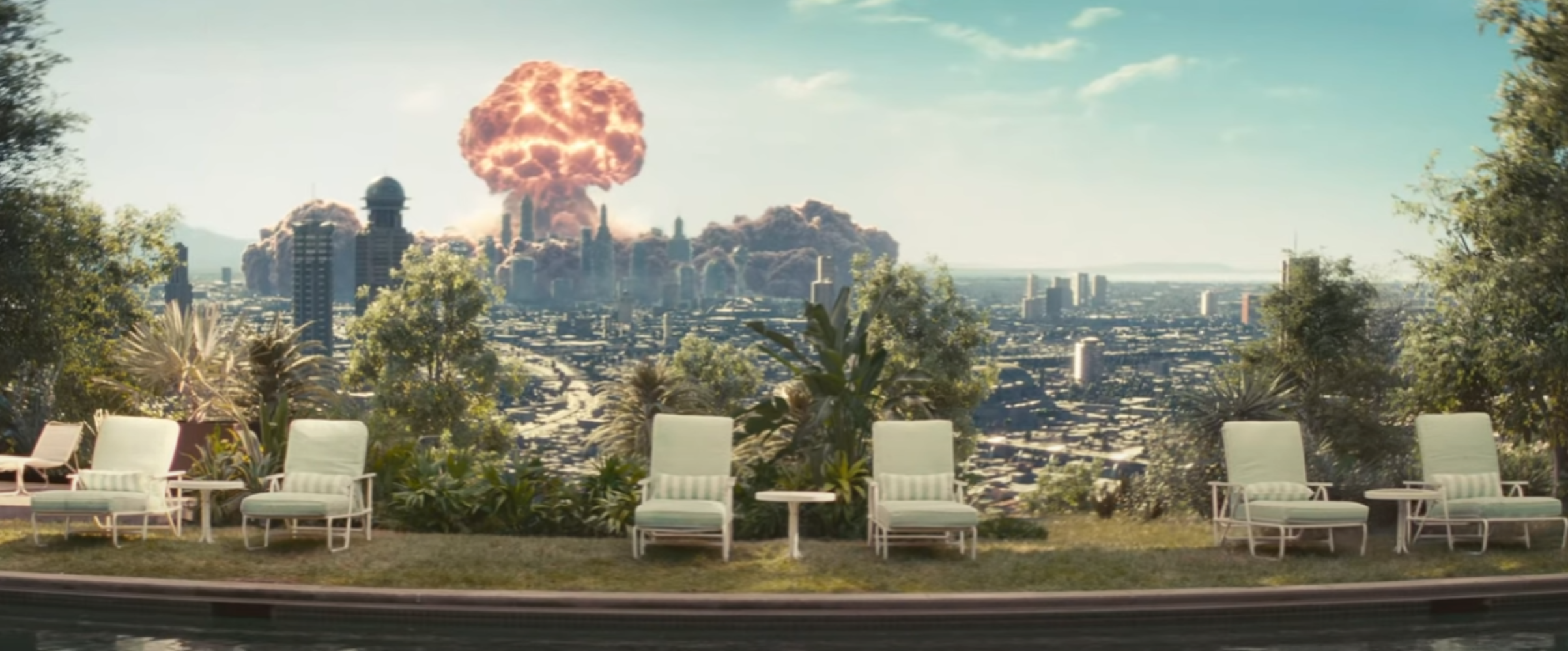
Building upon this definition, Borden and Essman claim that the post-Western reshapes the Western landscape, presenting a ‘dystopian vision’ while drawing on the aesthetics and features of the American frontier to critique contemporary social and political attitudes6. Considering this, a post-Western theoretical lens will prove beneficial in discerning the value of examining the ideological implications of Fallout’s (2024) rendering of post-apocalyptic Los Angeles.
The Death Of The American Myth
The opening scene of the first episode of Fallout (2024) immerses viewers in the retro-futuristic setting of Los Angeles. Despite the year being 2077, those unacquainted with the world of “Fallout” (1997-) might easily mistake that the show is attempting to depict the socio-political environment of the mid-to-late 1950s, an assumption reinforced by the inclusion of vintage fashion, retro technologies, and allusions to Old Hollywood. The audience’s initial exposure to the world places them in a modern and opulent Hollywood mansion where a wealthy family hosts a birthday party for their young son.
However, this ostentatious display of wealth and privilege is juxtaposed with hushed conversations regarding an imminent nuclear apocalypse, an eventuality that appears increasingly likely with each passing day. The opening scene navigates conflicting aesthetics, the foremost being the romanticization of America in the mid-20th century, a period characterized by a rejuvenated American ethos that praised American exceptionalism and freedom in the aftermath of an Allied victory during the Second World War. Despite this confidence and the perceived economic prosperity, the same period was marked by heightened Cold War anxieties.
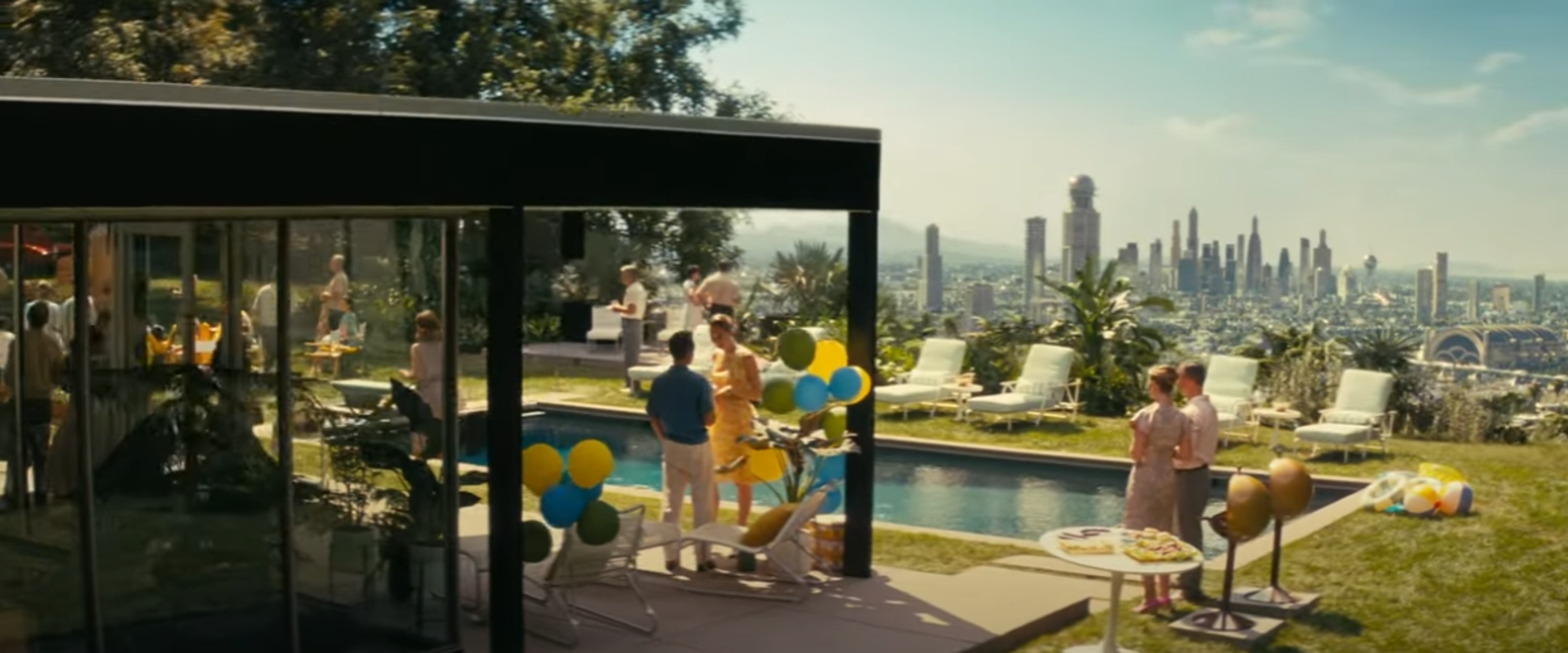
The retro-futuristic aesthetic of Fallout (2024) offers a veiled critique of American society during the era of nuclear anxiety. Although the Cold War concluded without a nuclear event, thereby prolonging the myth of American exceptionalism, Fallout (2024) endeavors to present an alternative narrative, exploring how American exceptionalist attitudes would unravel in the face of a catastrophic Cold War scenario.
According to the show, the outcome is a profound and immediate sense of disillusionment that is exemplified through the character of Cooper Howard, a notable actor who appeared in numerous popular Westerns. Although Howard’s cinematic roles are fictitious, he clearly embodies the values of the cowboys he portrays on screen. A decorated service member, a patriot, and a symbol of rugged masculinity, Cooper Howard embodied an idealized notion of the American Western mythos, both on and off-screen.
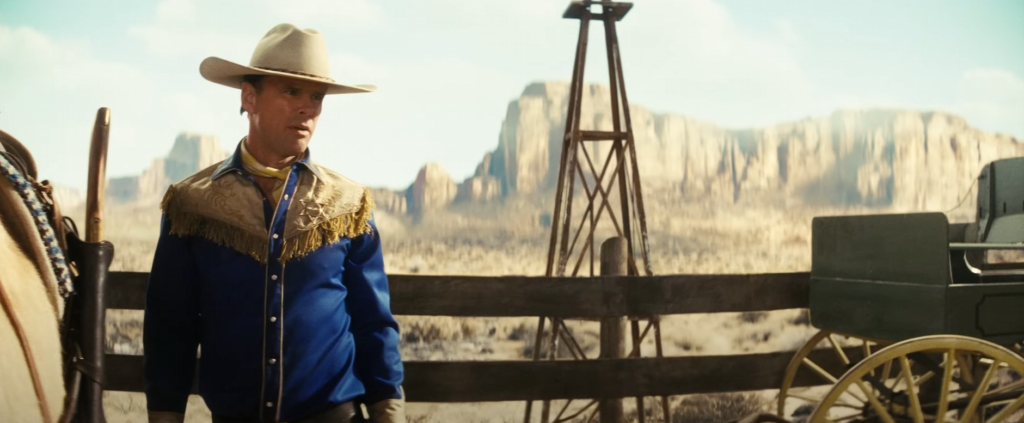
However, despite everything that Howard represents in the pre-nuclear era, it all becomes inconsequential once the mushroom cloud peaks over the Hollywood Hills. Any presumption that the American West (and by extension, America itself) was a realm of adventure, opportunity, and freedom is obliterated, for once the dust settles on the remnants of the United States, the vast expanses of wasteland signify the complete and utter failure of American exceptionalism, for those who remain are forced to pick up the pieces of a war of their nation’s own design. Through Howard’s transformation, the series critiques the fragility of American ideals in the face of apocalypse.
Satirical Reimaginings Of The Western Genre
As Fallout (2024) transitions into a post-apocalyptic setting, viewers are confronted with a critical and satirical portrayal of the region. Over 200 years after the nuclear event, Howard’s prolonged exposure to radiation has altered his appearance and significantly extended his lifespan. After centuries of traversing the post-apocalyptic West, Howard has assumed the persona of a cold-blooded yet proficient bounty hunter, a lifestyle and occupation reminiscent of the cowboy heroes he portrayed in the Western films of a bygone era. However, the post-Western setting and post-nuclear context offer an alternative rendition of the same narrative.
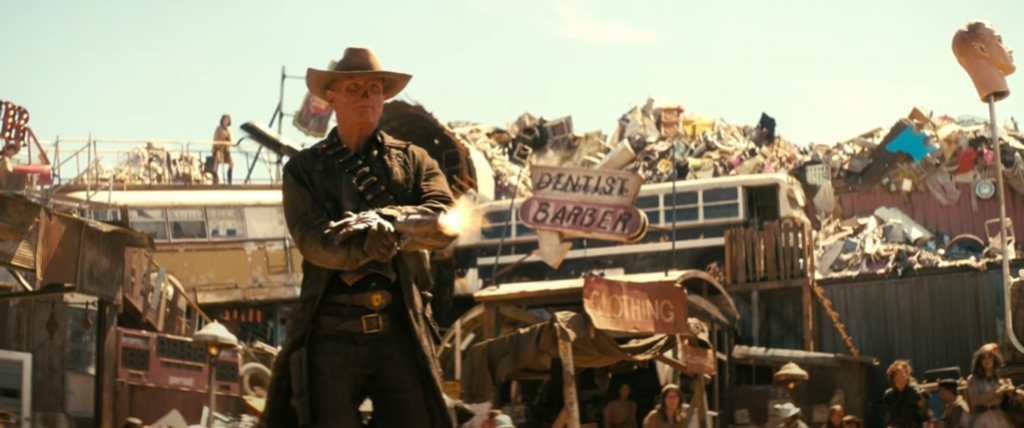
Howard, now the disfigured vagabond known as ‘The Ghoul,’ embodies the essence of the ‘Wild West’ upon his arrival in the town of Filly to capture a rogue Enclave scientist. Howard’s characterization is nostalgic, as he dawns a large hat, a trenchcoat, and an unwavering demeanor. In a moment of heightened tension, Howard resolves the confrontation with Filly through a gunfight, demonstrating remarkable accuracy while firing from the hip in classic Old Western fashion. However, the scene possesses a self-aware and satirical quality.
The shootout in Filly unfolds with intense gore, including exploding heads, severed limbs, and a dramatic slow-motion sequence showing a bullet piercing the heart of one man before penetrating the head of the man behind him. The exaggerated violence of Fallout (2024) borders on slapstick. Moreover, Howard amusingly interrupts the confrontation to indulge in handfuls of cherry tomatoes before resuming the action. These additional elements challenge any notion that Fallout (2024) seeks to offer a faithful reinterpretation of the Western genre, instead aiming to provide a critical reinterpretation of the Frontier West by deconstructing its most recognizable signifiers.
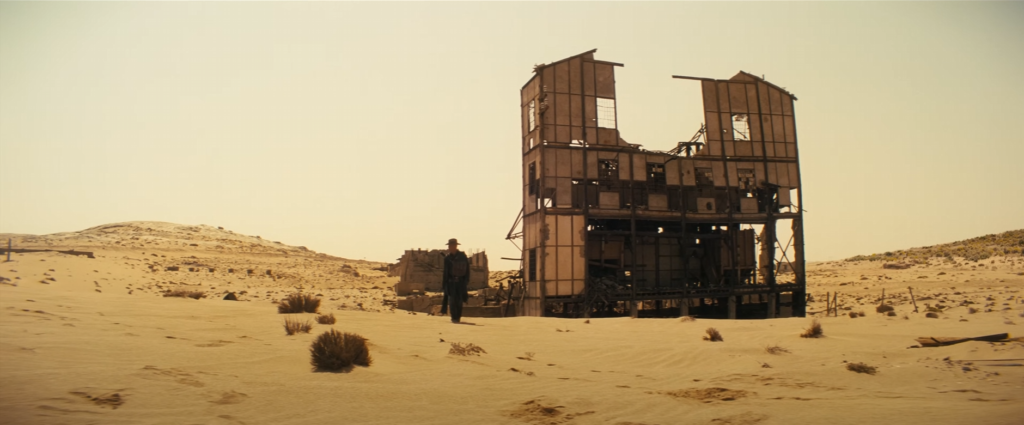
However, Howard’s outlaw escapades often contrast with his fulfilling life before the war, marked by professional success and his role as a devoted husband and father. Unlike traditional Western narratives, where the settlement and expansion of the Western United States symbolize progress and nation-building, Howard traverses the Western plains as a consequence of the United States’ systemic failure. In this narrative, the cowboy represents not rugged American masculinity, but the embodiment of America’s fall from grace as it grapples with an unprecedented collective trauma.
Deconstructing The Nuclear Frontier
Returning to the concept of the ‘American myth’, Mateusz Bogdanowicz theorizes that ideals of prosperity, wealth, success, modernity, progress, freedom, democracy, and a predisposition towards war and violence charcaterize the American cultural episteme7. Additionally, American cultural norms emphasize optimism, individualism, and the notions of remoteness and distance that are often associated with the American Frontier.
Further, according to the Turner thesis, the American spirit is deeply rooted in the Frontier experience and the doctrine of manifest destiny, meaning that stories set in the Western United States have historically served as a canvas for representing American sociopolitical landscapes8. These narratives may reinforce the American myth through idealized depictions of heroic figures bringing order to lawless lands or, as with Fallout (2024), they may deconstruct Western tropes in order to challenge prevailing narratives.
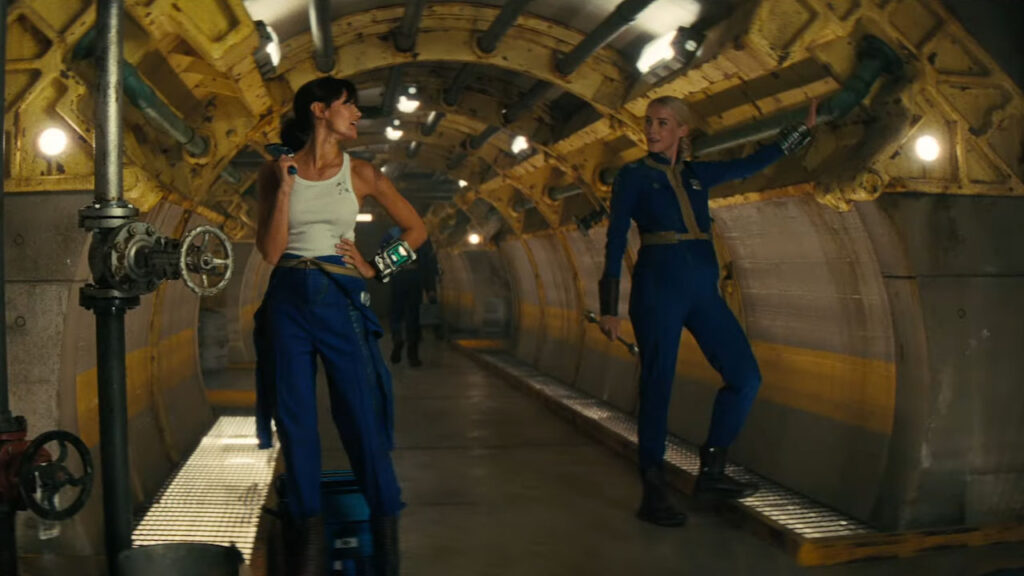
Amidst the post-Western context, viewers witness the deterioration of Howard’s belief in the American myth. Despite his patriotism and popularity, Howard cannot overcome the catastrophic consequences of America’s violent, pro-war attitude, as he is left to rot for eternity in the carcass of a nation that fed him false promises. In summary, the satirical portrayal of Howard as the ‘ghoul cowboy’ in Fallout (2024) attempts to deconstruct the American myth and offer a substantial critique of the potentially devastating consequences of American exceptionalism.
Los Angeles & Visions Of Eden
As a tribute to the “Fallout” (1997-) series, it makes sense to set the first season of Fallout (2024) in California. In the “Fallout” universe, California has a rich and complex political history, as it is the birthplace of the New California Republic and also the setting of the first two “Fallout” games. However, from a theoretical perspective, California also provides Fallout (2024) with an additional level of significance when examining America’s fall from grace and the deep sense of grief that the landscape evokes.
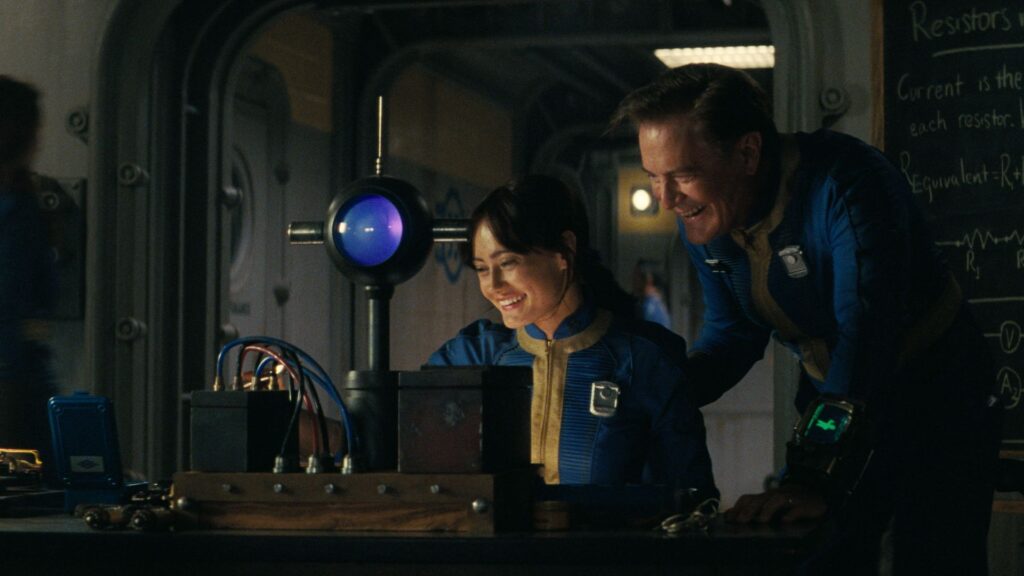
Reyner Banham’s conception of the city of Los Angeles in reference to the Garden of Eden is a valuable tool for unpacking the ideological implications of Californian narratives. Throughout recent history, Los Angeles has served as the location of the ultimate American escapist fantasy, due in part, as Banham explains, to the ecological marvel of the region.
‘Some of the world’s most spectacular gardens are in Los Angeles, where the southern palm will literally grow next to northern conifers, and it was this promise of an ecological miracle that was the area’s first really saleable product – the “land of perpetual spring.”’9
Paradise Lost
David Wyatt builds upon the notion of Los Angeles as Eden, outlining that the story of Eden is equally a story about loss and exile as it is a story about paradise10. Arguably, Wyatt’s interpretation of Banham’s Los Angeles becomes the ideal environment to explore the destruction of paradise at the hands of humanity and the devastating consequences of human greed. It is precisely through this framing of Los Angeles as a ‘lost paradise’ that Fallout (2024) equips environmental storytelling as a subtle constant reminder of the extent of the tragedy endured.
When Lucy leaves the vault to search for her father, blinding sunlight pours in from outside as the vault door opens. A building orchestral score creates a hopeful yet suspenseful atmosphere as Lucy prepares to leave the vault. The music reaches its climax as Lucy steps through the door. The image of Lucy entering into the illuminated abyss places her on the threshold between the dark world of the vault and the bright outside world, which creates the illusion that Lucy is about to step into an enlightened space.
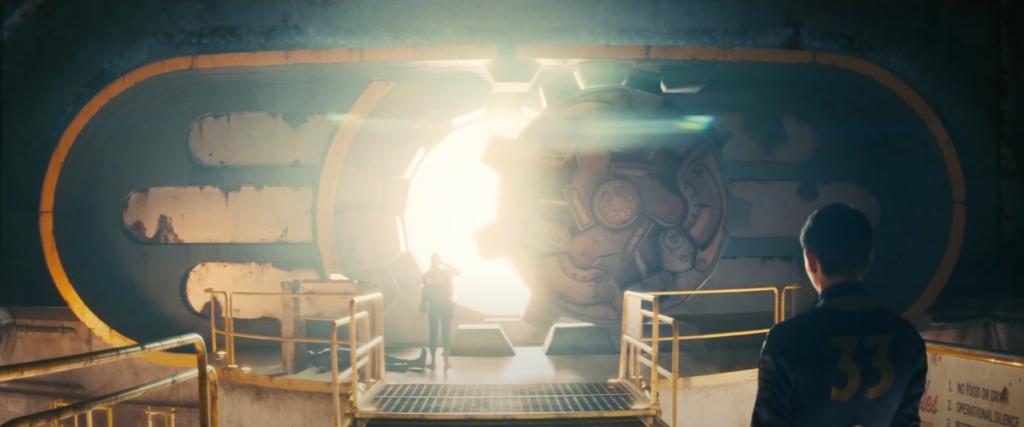
Because the audience’s vision is obscured by warm light as opposed to darkness, there is an unspoken assumption that the world outside the vault may represent an uncharted paradise, a magnificent coastal landscape that has been untouched by humanity for over 200 years and is now ripe and ready to be conquered.
However, as Lucy emerges on the other side of the vault door, the score fades to silence as she is greeted by an intense gust of wind. Lucy looks back anxiously as the vault doors close before the camera shifts focus to the landscape outside the vault, which is incredibly dry, desolate, and dawned with a scattering of human remains.
As Lucy anxiously ventures forward, audiences gain a greater scope of the level of extreme devastation and loss of life that occurred. As Lucy walks away from the vault, she encounters what remains of Santa Monica. The city has crumbled entirely, there is no color or sign of organic life, but the Santa Monica Pier remains somewhat intact, a symbolic reminder of what once was but can never exist again.
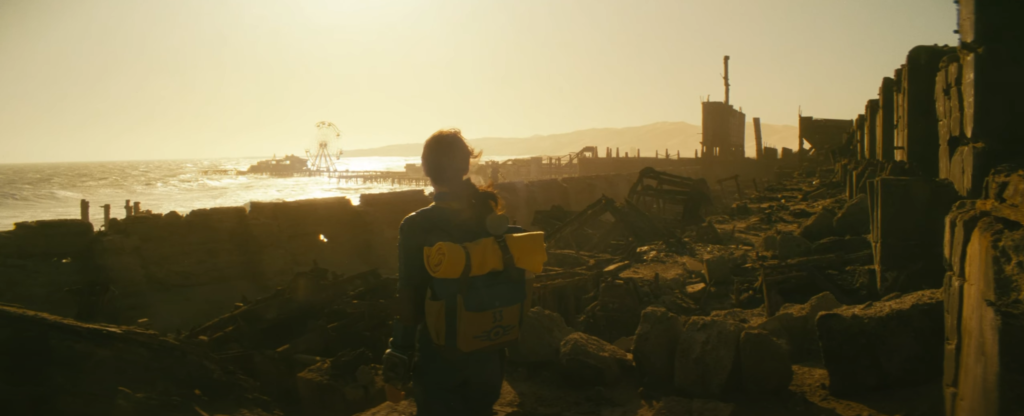
Apocalyptic renditions of recognizable locations across Los Angeles appear multiple times throughout the show, particularly during Lucy’s travels. Through Lucy, audiences uncover the devastating aftermath of post-nuclear Southern California. Despite the inclusion of fictional locations such as the Super Duper Mart or Red Rocket Truckstop (both derived from the “Fallout” games), the series consistently situates itself in reality, dispelling the notion that the story’s world exists in an alternate, fantastical reality.
Instead, Fallout (2024) portrays a fictional envision of the world, illustrating a grim conclusion to American history if the nation’s violent, pro-war culture persists despite an impending nuclear crisis.
Dismantling The Dream Factory
Fallout (2024) continues to present Los Angeles as a paradise corrupted by humanity in a scene when Lucy approaches an irradiated lake that was once a major freeway. The freeway has deteriorated into a damp dirt path overgrown with foliage. A decaying sign indicates the exit motorists would take towards Hollywood Boulevard, yet Hollywood is submerged underwater.
Sparse remnants of human existence, including crumbling buildings, are the only traces of what once was. If not for the directional sign, there would be no indication that Lucy had travelled to Hollywood, a journey that, in fiction, often represents a character’s desire to reinvent themselves or achieve a greater purpose. However, there is no greater purpose for Lucy in Hollywood, for like every other neighborhood in Los Angeles, it is merely a corpse of its former self.
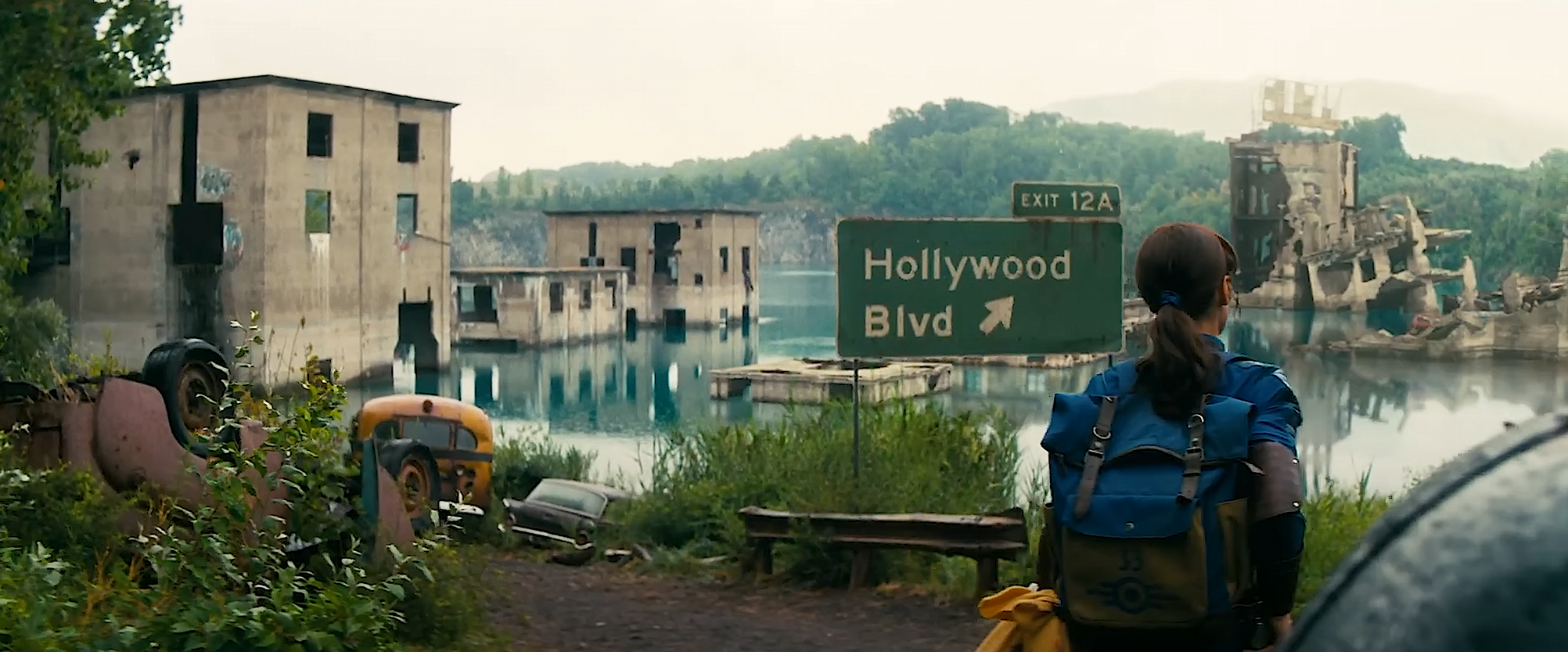
The depiction of an irradiated and deserted Hollywood carries significant symbolic weight. In an analysis of Nathaniel West’s classic Hollywood novel ‘The Day of the Locust’ (1939), Melanie Marotta explains that “California, specifically Hollywood…has become a refuge for those who desire to escape from unfortunate circumstances and who subsequently run towards more favorable ones, ones that appear to promise paradise.”11
Throughout history, Hollywood has served as the final frontier of the American Dream, the place where one can ‘be someone’. The demise of Hollywood symbolizes not only the death of the Dream but also the death of the idea that the American West is a land of opportunity and reinvention.
Through this post-Western reframing of Los Angeles, viewers confront an alternative vision of California that aids in deconstructing the American myth. By portraying Los Angeles as a fallen paradise, audiences face a dystopian view of an America predicted to crumble due to its failure to overcome its original sin, dooming paradise to the same fate as Eden. The show’s environmental storytelling prompts a critical reevaluation of contemporary American sociopolitical attitudes, hinting that without self-reflection, the modern world could meet the same fate depicted on screen.
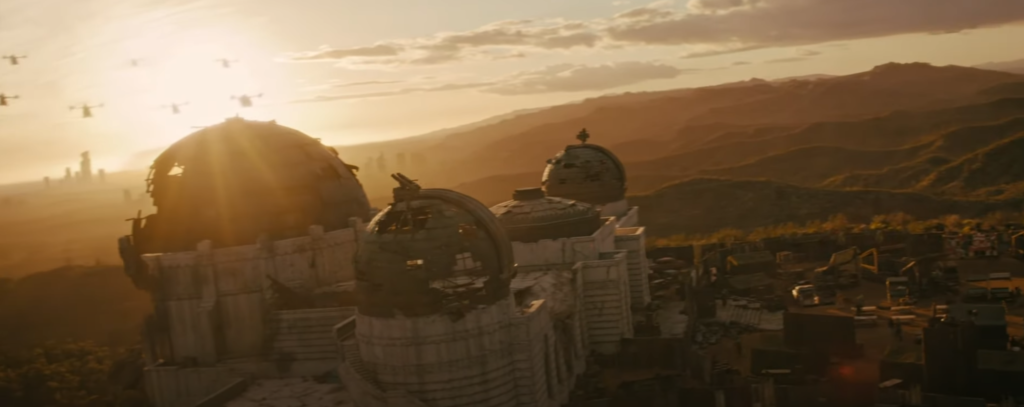
Furthermore, by situating instantly recognizable locations as the backdrop for the show’s most impactful establishing shots, Fallout (2024) associates the iconic Los Angeles landscape with the ravages of war, suggesting that an unchecked belief in the American myth and the pursuit of American exceptionalism will cannibalize the nation, leaving nothing to show for its endeavors in war, power, and global dominance.
Fallout — Settling The Dust
As supported by French, Borden, and Essman’s interpretations of the post-Western landscape, Fallout (2024) creatively reinvents the Western genre through its critical and satirical treatment of Western narrative tropes and its dystopian reimagination of the California landscape. The series’ post-Western elements collaborate to expose the limitations of the classic Western and the inaccuracies of the American myth. Further, the series utilizes its post-apocalyptic setting to deconstruct contemporary social and political attitudes.
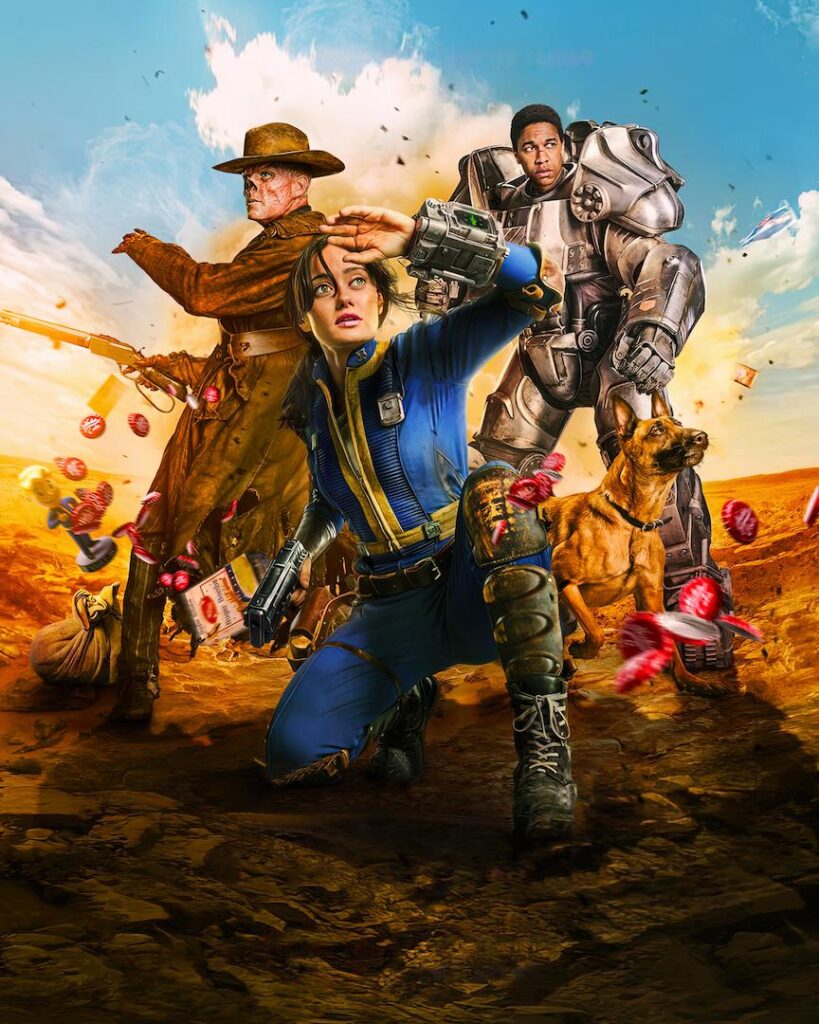
Examining Fallout (2024) as a post-Western narrative suggests that the series is ideologically driven and aims to disrupt dominant narratives about the United States’ handling of global conflicts, both contemporary and historical. In conclusion, Fallout (2024) is more than a successful video game-to-television adaptation; it is a standout contributor to the body of media and literature that attempts to redefine the spirit of the American West on its own terms.
- Mangan, Lucy. “Fallout Review – an Absolute Blast of a TV Show.” The Guardian, 11 Apr. 2024, theguardian.com. Accessed 6 May 2024. ↩︎
- Kain, Erik. “‘Fallout’ Is Terrific, but Amazon Made One Huge Mistake.” Forbes, 16 Apr. 2024, forbes.com. Accessed 6 May 2024. ↩︎
- Tinubu, Aramide. “Prime Video’s Fallout Is an Ultra-Violent and Twistedly Fun Video Game Adaptation: TV Review.” Variety, 10 Apr. 2024, variety.com. Accessed 6 May 2024. ↩︎
- Bogdanowicz, Mateusz. “What Is the American Myth Really Like?” Ad Americam, no. 15, 2014, p. 15. ↩︎
- French, Philip. Westerns. Carcanet, 2005, pp. 84–85. ↩︎
- Borden, Diane M., and Eric P. Essman. “Manifest Landscape/Latent Ideology: Afterimages of Empire in the Western and ‘Post-Western’ Film.” California History, vol. 79, no. 1, 2000, p. 36. ↩︎
- ibid. ↩︎
- Turner, Frederick Jackson. The Frontier in American History. Henry Holt and Company, 1921, pp. 1–38. ↩︎
- Banham, Reyner. Los Angeles: The Architecture of Four Ecologies. University Of California Press, 2001, p. 13. ↩︎
- Wyatt, David. The Fall into Eden. Cambridge University Press, 1990, p. 207. ↩︎
- Marotta, Melanie. “Longing for Fulfillment: The Temptation of the Californian Life in Sam Shepard’s True West and Nathanael West’s The Day of the Locust.” Edited by Philip Varner, New Wests and Post-Wests: Literature and Film of the American West, Cambridge Scholars Publishing, 2013, p.30 ↩︎
